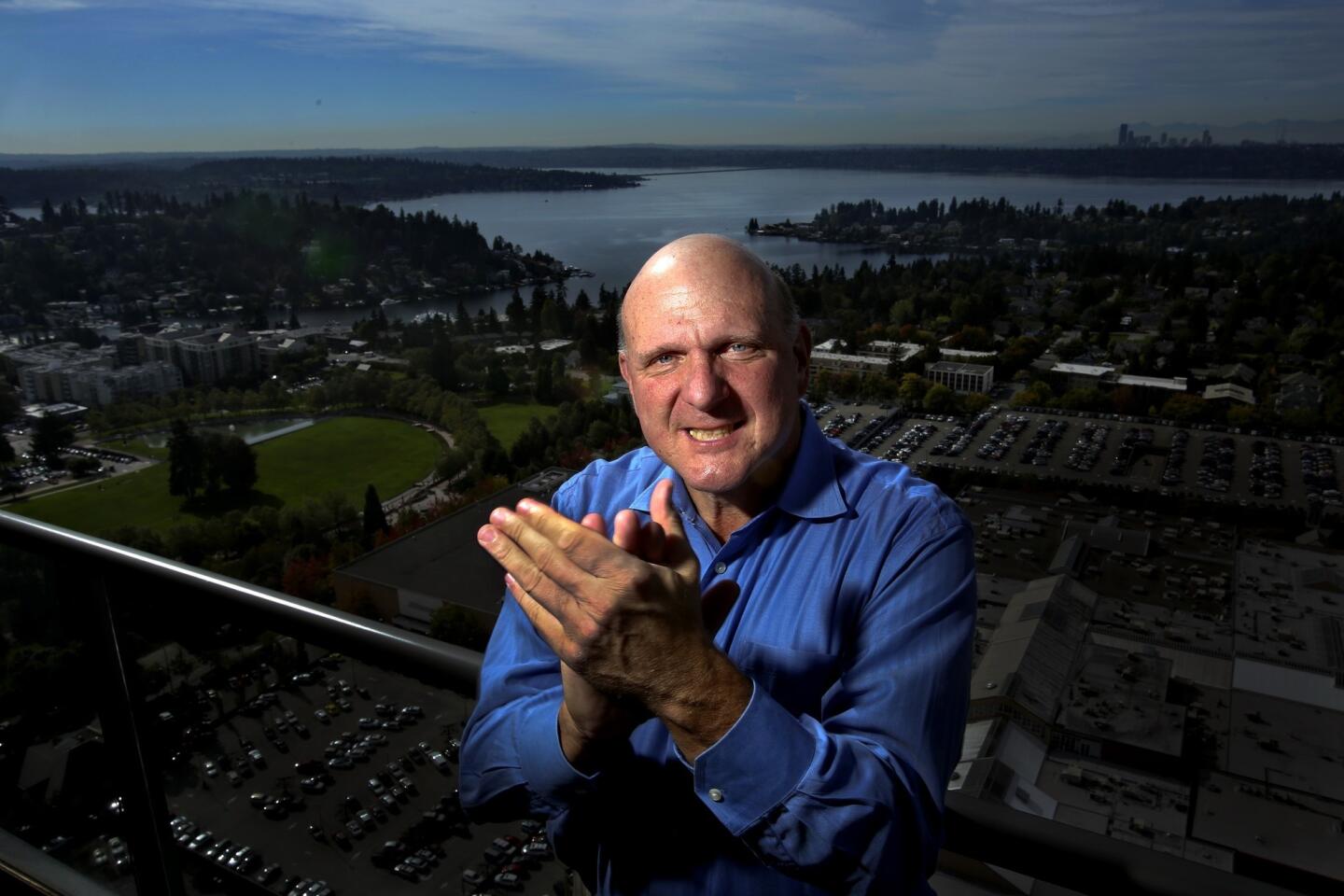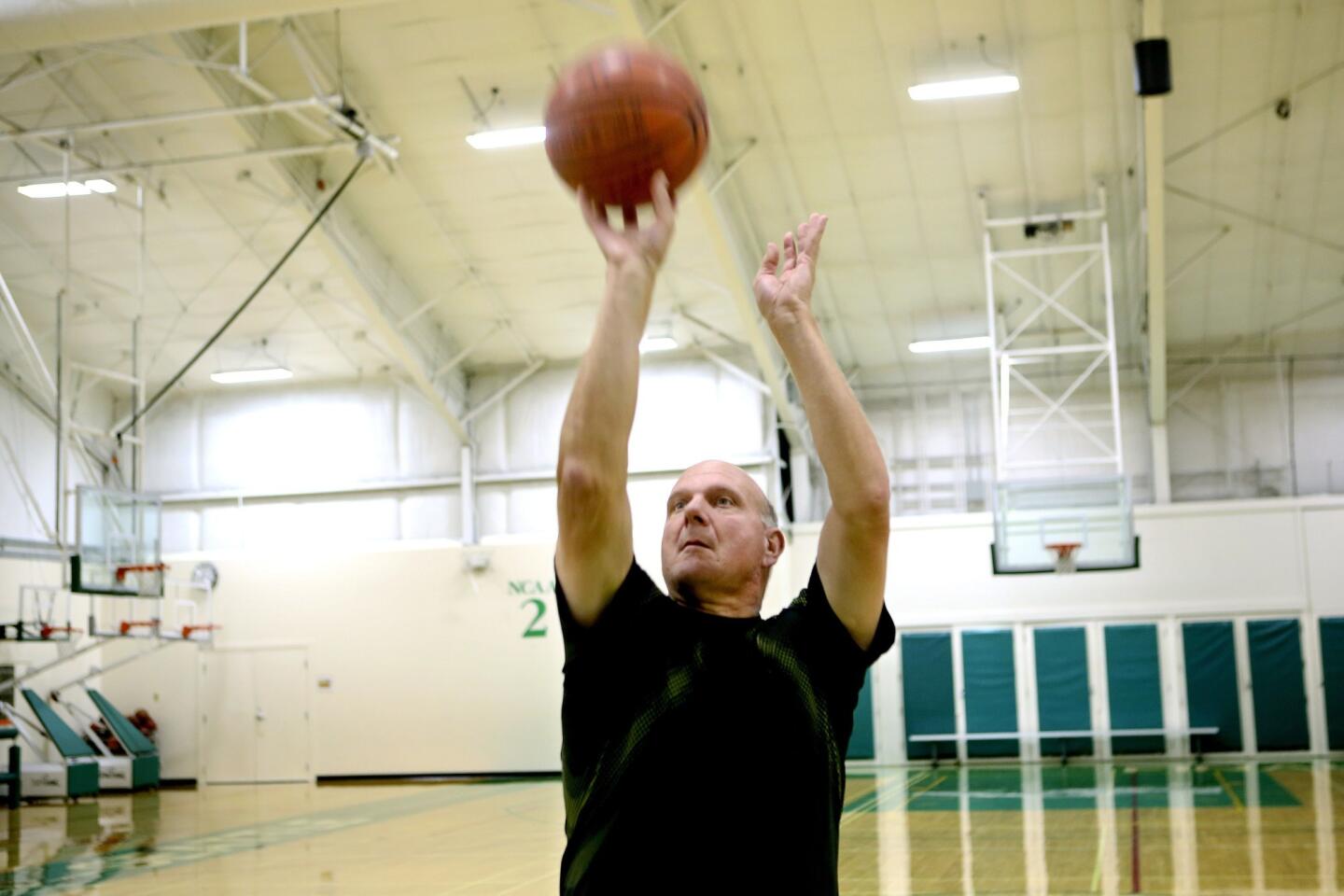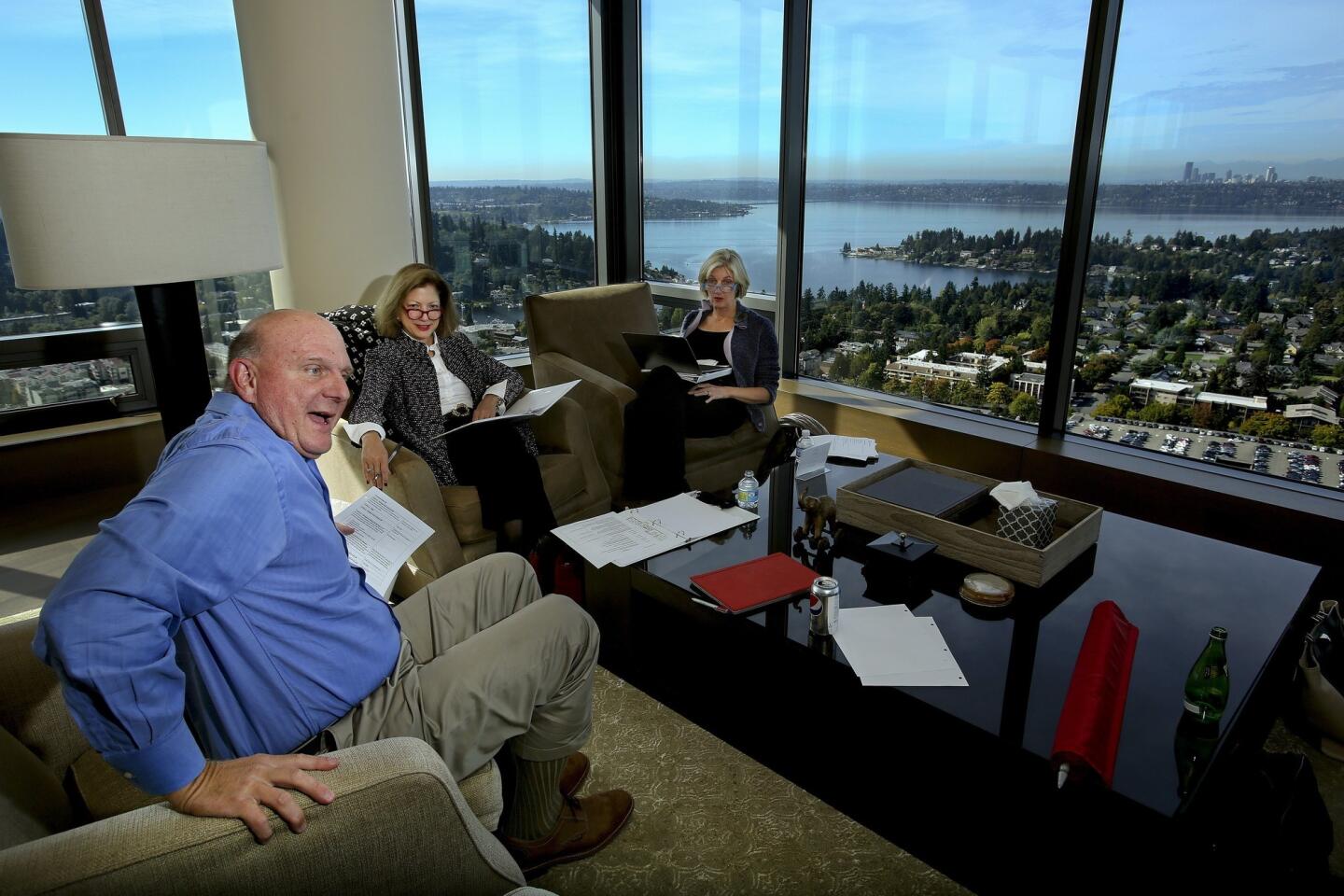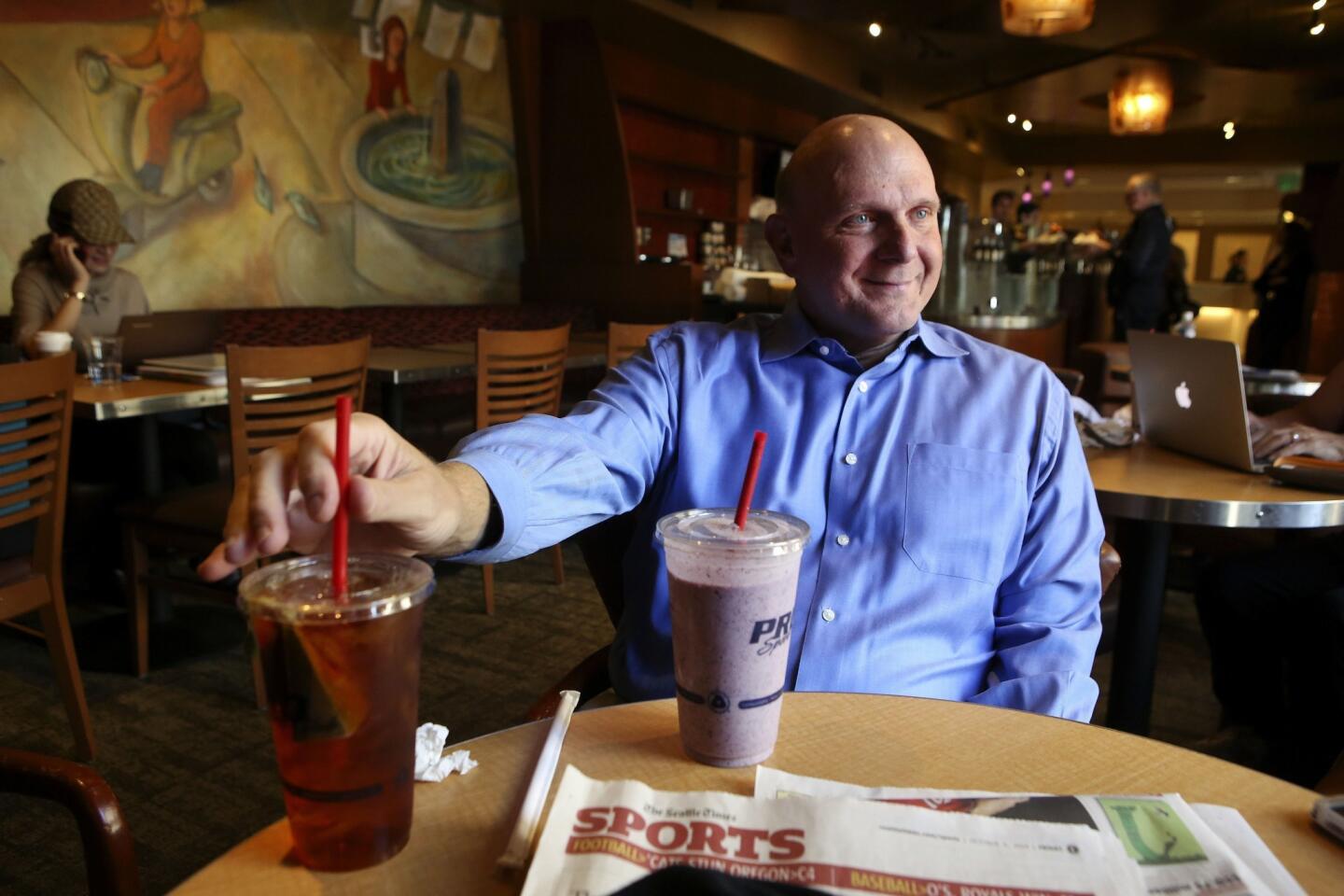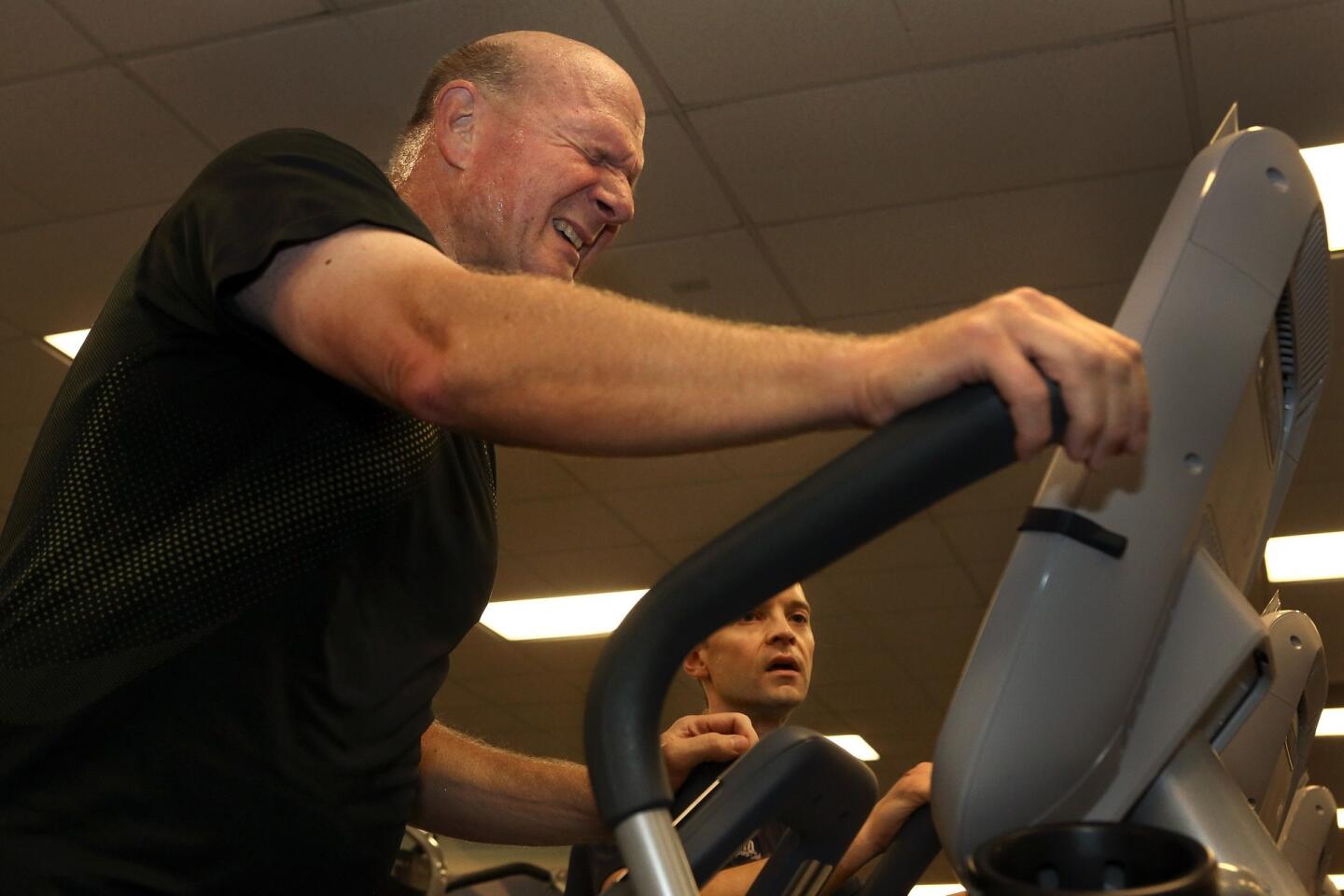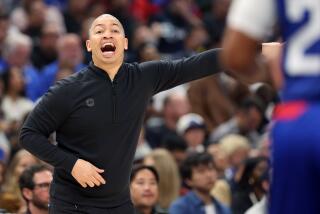Steve Ballmer opens a new window as Clippers’ enthusiastic owner
- Share via
Reporting from Bellevue, Wash. — Steve Ballmer delivered many lessons this fall to the 80 students who squeezed their way into his much-anticipated class at the Stanford Graduate School of Business.
Never forget, the former Microsoft chief executive told them, that at the heart of every successful company there beats a compelling story. The budding capitalists would need to embrace their companies’ stories wholeheartedly. And yet, he cautioned, be prepared to change course at any moment.
“No one is ever going to forget your old story,” Ballmer told a small group that huddled around him after class this month. “But, occasionally, you get a chance to reboot.”
At 58 and less than a year after stepping down as head of one of the world’s largest corporations, the inveterate basketball gym rat, conjurer of manic YouTube moments and erstwhile pal of Microsoft founder Bill Gates arrives this week in Los Angeles to begin his own reinvention. Call it Ballmer2014.
The bald-headed, linebacker-sized new owner will be sitting under the basket closest to the Clippers bench when his NBA basketball team takes on the Oklahoma City Thunder at Staples Center in the season opener Thursday night.
He comes south from his long-time Seattle-area home pledging big things: to help push the Clippers to an NBA championship and to infuse serious civic muscle into an organization laid low by its previous owner. (Donald Sterling being better known, after all, for focusing on Donald Sterling.)
While his record $2-billion acquisition of the franchise last May understandably has occupied much of his time recently, the post-corporate Ballmer has other imperatives as well. Prime among them: deciding how he can best apply some of his fortune — estimated at $22.5 billion, making him 21st on Forbes’ list of wealthiest Americans — to the myriad problems facing the nation and, not coincidentally, his newly adopted city.
Ballmer also has refocused on fitness (targeting a dozen-pound reduction from his nearly 6-foot, 232-pound frame), crowded his calendar with golf (in “burst modes” of up to 36 holes a day) and returned to long-lapsed Hebrew studies. A decades-delayed bar mitzvah party seems more certain, at least for now, than an NBA championship fete.
Yet no measure of re-creation will erase the other Ballmer, the one who started at Microsoft in his mid-20s and who headed the 128,000-employee company for 14 years. He shepherded one of the greatest profit machines in American corporate history, and bridles at post-mortems that focus, instead, on how Microsoft lost its innovative edge, allowing Google and Apple to gain tech sector dominance.
Since he walked out of his office at the expansive Microsoft campus in the Seattle suburb of Redmond nine months ago, the company’s stock has run up by 26%. That has made Ballmer, Microsoft’s single biggest individual shareholder, $3 billion richer. But the credit has gone to his successor, Satya Nadella.
“My work at Microsoft you would have to say was my true calling. … It was important. Lives got transformed. Jobs got created,” Ballmer said, as he churned through 18-calorie minutes on an elliptical at a gym in Bellevue, near Microsoft.
A few big gulps of air later, he offered a slightly modified expectation of a life now centered on basketball. “This is a deep passion,” he said, “and hopefully a lot of fun.”
::
Ballmer’s public introduction to Los Angeles came two months ago, when he stormed onto the floor of Staples Center for the Clippers’ “Fan Festival.” The mid-August rally followed a judge’s ruling that completed Sterling’s ouster and cleared the way for Ballmer’s ascension.
More than 5,000 fans responded in giddy amazement as Ballmer skipped and jumped among them, high-fiving and pounding fists. “Boom! Keep coming!” he screamed. “The hard-core Clippers, that’s us!”
Sports ownership in Los Angeles had never before produced such shock and awe.
“His face gets all red. His hands get all sweaty,” Clippers forward Matt Barnes said later. “I think it’s refreshing to have someone who shares that same enthusiasm about winning that you do.”
Despite the histrionic coming out, most of the early Ballmer tenure has been measured, even quiet.
He does not attend practices. He appeared at only two of eight preseason games. He quickly extended Coach Doc Rivers’ contract through the 2018-19 season, at more than $10 million a year.
Though he’s a long-time NBA fan, and is knowledgeable about many players, he hasn’t pushed personnel moves, and talks to Rivers just once a week for about an hour.
In fact, Rivers said he would welcome more opinions from his new boss, a man who paid more than three times the previous record price for an NBA team. “There’s nothing wrong with having an opinion. I told him that,” Rivers said. “That doesn’t mean you have to agree, but [he has] the right to have a voice.”
The one unusual request Ballmer has made was that his coach help write a series of principles.
The resulting one-page “Clippers Credo” preaches the sort of “HARD CORE” devotion Ballmer and Gates had espoused since Harvard. A sample offering on “Toughness”: “We play all-out, committed, competitive basketball. Nothing will be easy for our opponents.”
Others might hear platitudes, but Ballmer argues “optimism can be a force multiplier.”
Fans should be ready for opening-night flourishes. Ballmer pledges more, and better, statistics and highlights. They could be delivered via the Jumbotron, or a smartphone. Along with the standard box score, why not an online graphic diagramming shooters’ makes and misses?
Attending Seahawks games with owner and fellow Microsoft chieftain Paul Allen, Ballmer said, he has seen the power of fan fervor. “12th man, baby!” he barked, adding another fist pump.
“We want better energy. I do. The players do. Doc does. Everybody does,” Ballmer said. “More. Better. We would love to be known for the most energetic fans in the NBA.”
Fans roared their approval when the new owner appeared on the Staples Center big screen at Wednesday’s preseason win over the Phoenix Suns. Rivers joked he needed the media to help him keep track of Ballmer’s antics. But Ballmer clearly is conscious his players and high-flying “Lob City” remain the show.
He said he envisions support for the Clippers growing this way: “Enjoy. Support. And then more enjoyment. BOOM! More support. Then, BOOM! More enjoyment. It’s a snowball.”
::
Ballmer grew up comfortably in suburban Detroit. His father had emigrated from Switzerland and worked as a manager for Ford Motor Co.
Ballmer recalled being so frenetic in second grade that his teacher (“Miss von Stichel,” he snarled whimsically, through clenched teeth) dubbed him “addled.” He studied so hard, to compensate, that he ended up skipping third grade.
He then wanted to attend the prestigious Detroit Country Day School and his mother said he could, but only if he earned an academic scholarship. He did and went on to become valedictorian. An 800 on the math portion of the SAT helped pave his way to Harvard.
His meeting there with Gates, who lived just down the hall, is now part of Microsoft legend. When Ballmer moved on to Stanford’s business school, Gates coaxed him to leave early and join Microsoft, then a company of 30 employees.
The two built a juggernaut so dominant the U.S. Justice Department pursued it as a predatory monopoly. Microsoft settled, but could not shake a reputation as an overweening corporate bully.
As consumer preferences swung from PCs to smartphones and tablets, Microsoft’s leading share of tech profits slipped away. The charm of the rambunctious, cheerleading Ballmer also lost luster as the company’s profits were eclipsed by others. He became a YouTube foil for Apple’s turtle-neck-wearing Steve Jobs and his pose of cosmic cool.
But Microsoft’s legacy franchises — Windows and Office (with its Power Point, Excel and more) — helped deliver $241 billion in profits during Ballmer’s time in charge. One recent estimate suggests 92% of laptop and desktop computers still run on Microsoft software.
“He is the Babe Ruth of CEOs,” said Mark Penn, Microsoft’s chief strategy officer. “He had some strikeouts but also some enormous home runs, and the home runs propelled the company....when so many other tech companies struggled.”
Microsoft leaders love to brand watershed moments with big pop music. Ballmer launched his first meeting at the company in 1983 with Michael Jackson’s “Wanna Be Startin’ Something.” For his final mass gathering with the company’s workers, the CEO chose “(I’ve Had) the Time of My Life.” Alone under a spotlight in a darkened auditorium, he wept.
Ballmer’s famously close, and fractious, friendship with Gates has been on the skids since his waning days at the company, reportedly as Ballmer felt his old confederate failed to back his continued tenure in the top job. Ballmer won’t talk about the split. He notes pointedly, however, that Gates has unloaded Microsoft stock, while he stands pat with 333 million shares.
Ballmer’s epitaph could read “The Loyalist.” And not just because of his devotion to Microsoft, but for the way he clings to people and institutions from his near and distant past.
Ballmer has always driven a Lincoln, because his dad worked at Ford. When he sits down courtside on opening night, he will be with his wife, Connie, and his son, Sam, who is finishing his final semester at USC, and Chaz Fitzhugh, a friend he met in his first days at Harvard.
The owner plans to keep his home, and many close ties, in the Seattle area. His place is in Hunts Point, a tony evergreen peninsula that juts into Lake Washington. It is neither gated, nor flashy. He intends to establish a second home in L.A., but hasn’t found one yet.
For years, he played hoops with Microsoft pals every Wednesday before dawn, exhibiting a semi-sweet touch from the three-point line. A bum ankle, he said with regret, ended his basketball days.
Not coordinated or springy enough to make his high school basketball team, he still growled with delight when recalling a schoolmate scoring 53 points in one game. “It was a big night!” he said, voice scaling to high volume at the memory. “It was one of those big nights you remember!”
::
At the Pro Club, the bustling gym in Bellevue where Ballmer works out, the Microsoft-heavy clientele has long since stopped blinking at their former boss’ effusive, borderline-eccentric ways.
No one looked up when he shouted across the lobby to an employee (who has a son preparing for a high school football game): “It’s all about this weekend!” Or when, on cold days, Ballmer used to venture out for runs with tube socks pulled over his hands. He told his trainer they were easier to replace than fancy gloves.
His casual insouciance emerges in other settings.
When the new president of Harvard came calling for the first time in Seattle, he took her to dinner. At Subway. Then they were off to his son’s lacrosse game.
Not that the man now ranked as the richest owner in American sports lives an ascetic existence.
His personal jet shuttles him between Seattle and L.A.
A new office suite with ceiling-high windows in every direction — on the 40th floor of a Bellevue skyscraper — provides a Master of the Universe-sized panorama. The Clippers boss can gaze across shimmering Lake Washington to downtown Seattle and the verdant Olympic Peninsula beyond. Mt. Rainier looms to the southeast.
This month, Ballmer sat slumped in an armchair in his aerie as four visitors discussed details of a major donation to a prestigious institution that Ballmer soon will announce.
He mused it would be fun to have breakfast, after the ceremony, with an acquaintance who happened to be a former U.S. Cabinet secretary. Within a couple of minutes and with a few emails, one of his guests had the potentate lined up for the meeting.
When $22.5 billion, or a hunk of it, goes looking for a meaningful landing place, doors open. Ballmer has talked economic policy with former Fed chairman Ben Bernanke and broken down federal priorities with Jason Furman, chairman of President Obama’s Council of Economic Advisers. Platoons of U.S. senators and academics have cleared time to talk shop with the inquisitive one-time math and economics major.
In the past, he and Connie — who are parents to three boys, two in college and one a high school sophomore — gave $10 million to help found a foster care-focused nonprofit in Washington state. They also backed a program boosting youth athletics and academics.
On the political front, Ballmer, who labels himself nonpartisan, has given more than $1 million to a measure seeking universal background checks for gun sales in Washington.
He said he is determined to make his giving count. “You have got to ask the questions before you just run off helter skelter and do your own thing,” Ballmer explained, as he downed first a giant protein shake and then a giant iced tea after his morning workout. “In a world of scarce resources, what do you do?”
In Ballmer’s fanatic, almost translucent, blue eyes, it’s not hard to imagine the boy who so loved the Pistons of Dave Bing and Big Bob Lanier. He still marvels at the way the massive center could glide and bang, in size 22 shoes. He attended nearly 100 AAU, high school, college and pro basketball games in the last year and rhapsodized about the speed and “independent decision making” of the game.
He told the Clippers he would be absent for a few games this year, when his youngest son is playing basketball for Seattle’s Lakeside High School. Ballmer apologized, but All-Star guard Chris Paul said he respected the boss’ priorities.
The owner is thrilled the Clippers’ first opponent this season will be the Thunder, the team that abandoned Seattle for Oklahoma City. He knows it’s just one game. But he wouldn’t mind a little payback.
“There is some juice that comes with that,” Ballmer said, beaming. “There definitely is some JUICE!”
@latimesrainey
More to Read
Sign up for Essential California
The most important California stories and recommendations in your inbox every morning.
You may occasionally receive promotional content from the Los Angeles Times.
